These 645-square-foot domed buildings were printed in Italy over the course of 200 hours.
Category: habitats – Page 77
SpaceX Starship SN 11 Findings and Fixes
Elon Musk has given us his findings to why the SpaceX Starship SN 11 exploded above the landing pad.
I explore fixes from a system safety standpoint. See what I recommend.
You can support Galactic Gregs by supporting the sister channel Green Gregs by clicking the links below:
See the Special Deals at My Patriot Supply (great space mission food): www.PrepWithGreg.com.
For gardening in your space habitat (or on Earth) Galactic Gregs has teamed up with True Leaf Market to bring you a great selection of seed for your planting. Check it out: http://www.pntrac.com/t/TUJGRklGSkJGTU1IS0hCRkpIRk1K

Home | Philadelphia
The company working on a militarized version of BD’s Spot. It looks like just a straight copy. Sadly, no FB page, and didn’t see any other robots on there besides this. I think some humanoid robot competition would be helpful.
© 2020 Ghost Robotics Corporation® Ghost Robotics & Logo are registered trademarks.
Privacy & Legal
SpaceX Starship Recommendations and SN 11 Crash
See my recommendations to get Starship landing, videos, and discussions of quantity distance and other aspects of safety and mission assurance that could potentially help assure successful Starship flights.
You can support Galactic Gregs by supporting the sister channel Green Gregs by clicking the links below:
See the Special Deals at My Patriot Supply (great space mission food): www.PrepWithGreg.com.
For gardening in your space habitat (or on Earth) Galactic Gregs has teamed up with True Leaf Market to bring you a great selection of seed for your planting. Check it out: http://www.pntrac.com/t/TUJGRklGSkJGTU1IS0hCRkpIRk1K

A2Z Drone Delivery Rapid Delivery System Means Drones Don’t Have to Land at Your House
We wrote about DroneUp’s drone delivery of Coke with Coffee to residents in Coffee, GA – but how exactly did that delivery work? The A2Z Rapid Delivery System allowed packages to be delivered without landing the drone – a method that solves a lot of problems in drone delivery.
CA-based A2Z Drone Delivery, LLC, has developed a patented tethered freefall drone delivery mechanism, the Rapid Delivery System (RDS1) used by DroneUp® for the project with Walmart and Coke. The RDS1 system lowers the delivery to the ground by tether – which means that homeowners don’t have to worry about a noisy landing or the potential for a landing drone to hit obstacles on its way down. “The RDS1 was chosen for its rapid delivery capabilities which reduced time-on-station to just 30 seconds per delivery, while minimizing intrusive rotor noise and limiting the window for risk to people on the ground,” says an A2Z press release.
“For our partners at DroneUp to put their trust in our system was the best proof of concept that we could imagine and was a memorable benchmark for our whole team,” said Aaron Zhang, founder of A2Z Drone Delivery, LLC. “The unique capabilities of the RDS1 were tailor-made for this type of residential delivery where our tethered freefall mechanism can accurately and quickly deposit payloads while hovering far from people, homes, trees and utility wires.”

First house on the moon could be yours for $60M: study
The first house on the moon, an ambitious space-saving alternative to life on crowded Earth, could cost an out-of-this-world $60 million, according to a new study.
That’s an estimated $320000 monthly payment for 1356 square feet of interior space, so if you want to go big, stay home.
The study, conducted by the UK finance site Money.co.uk, used SpaceX’s blastoff weight pricing to estimate what it would cost to bring materials, tools and laborers to the moon to begin the work. It also factored in the costs of new technology that architecture on the moon would require for life support and other factors.

Homeless man becomes first person to live in 3D-printed house — see inside
“I hope I stay here until my last dying days.”
Those are the words of Tim Shea, who has come a long way since his days as a homeless man once struggling with heroin addiction. He is now the first person ever to live in a 3D-printed house, according to the home’s maker.
On the outskirts of Austin, Texas, 70-year-old Shea has settled into his 400-square-foot home constructed by 3D printing. His new home is situated in the Community First! Village site, which is comprised of houses for the chronically homeless.

SLS Core Stage Firing Test 2 Green Run Hot Fire
Success! The SLS Core Stage had a successful eight minute hot fire test at NASA’s Stennis Space Center on 18 March 2021. See the run down to and the full duration eight minute firing of the Core Stage of the Artemis 1 Space Launch System. Now on to KSC and launch!
Engines fire at timestamp 44:09
For gardening in your space habitat (or on Earth) Galactic Gregs has teamed up with True Leaf Market to bring you a great selection of seed for your planting. Check it out: http://www.pntrac.com/t/TUJGRklGSkJGTU1IS0hCRkpIRk1K

Rare Meteorite that Fell on UK Driveway May Help Decode History of Solar System, Life on Earth
A fireball that lit up the sky over the United Kingdom and Northern Europe on February 28 was an extremely rare type of meteorite. Fragments of the space rock discovered on a driveway in the Cotswolds could provide answers to questions about the early history of the solar system and life on Earth. Almost 300 grams (10.6 ounces) of the meteorite have been collected from the small Gloucestershire town of Winchcombe by scientists, who said the rock was formed of carbonaceous chondrite. The substance is some of the most primitive and pristine material in the solar system and has been known to contain organic material and amino acids — the ingredients for life.
The Natural History Museum in London said the fragments were retrieved in such good condition and so quickly after the meteorite’s fall that they are comparable to rock samples returned from space missions, both in quality and quantity. “I was in shock when I saw it and immediately knew it was a rare meteorite and a totally unique event. It’s emotional being the first one to confirm to the people standing in front of you that the thud they heard on their driveway overnight is in fact the real thing,” said Richard Greenwood, a research fellow in planetary sciences at The Open University, in a statement from the museum. He was the first scientist to identify the meteorite.
There are approximately 65000 known meteorites on Earth, the museum said. Only 1206 have been witnessed to fall, and of these, only 51 are carbonaceous chondrites. The fireball was seen by thousands of eyewitnesses across the UK and Northern Europe and was captured on home surveillance and other cameras when it fell to Earth at 9:54 p.m. GMT on February 28. The original space rock was traveling at nearly 14 kilometers per second before hitting the Earth’s atmosphere and ultimately landing on a driveway in Winchcombe. Other pieces of the meteorite have been recovered in the local area. Footage of the fireball shot by members of the public and the UK Fireball Alliance camera networks helped locate the meteorite and determine exactly where it came from in the solar system, the museum said.